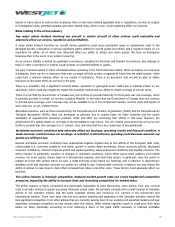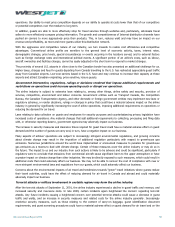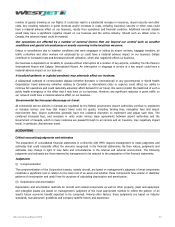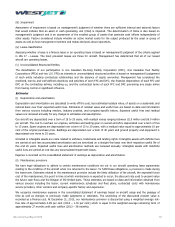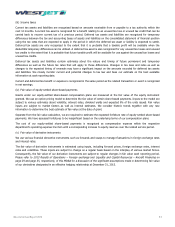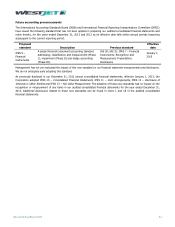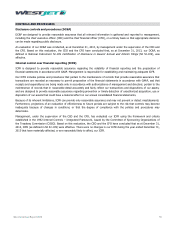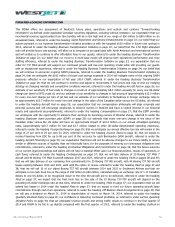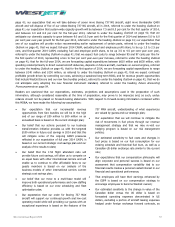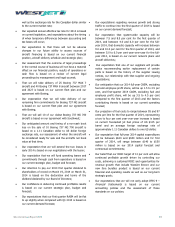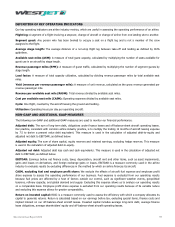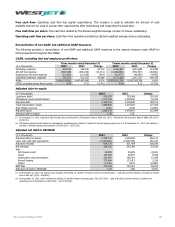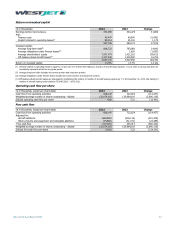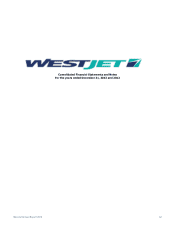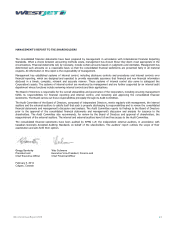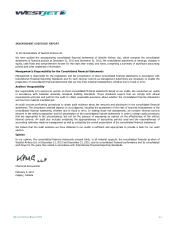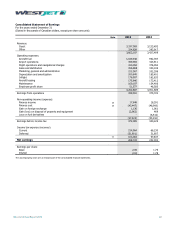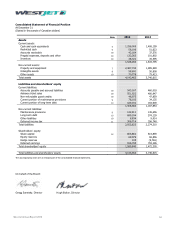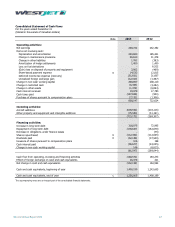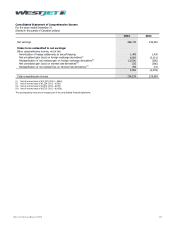Westjet 2013 Annual Report Download - page 59
Download and view the complete annual report
Please find page 59 of the 2013 Westjet annual report below. You can navigate through the pages in the report by either clicking on the pages listed below, or by using the keyword search tool below to find specific information within the annual report.
WestJet Annual Report 2013 59
DEFINITION OF KEY OPERATING INDICATORS
Our key operating indicators are airline industry metrics, which are useful in assessing the operating performance of an airline.
Flight leg: A segment of a flight involving a stopover, change of aircraft or change of airline from one landing site to another.
Segment guest: Any person who has been booked to occupy a seat on a flight leg and is not a member of the crew
assigned to the flight.
Average stage length: The average distance of a non-stop flight leg between take-off and landing as defined by IATA
guidelines.
Available seat miles (ASM): A measure of total guest capacity, calculated by multiplying the number of seats available for
guest use in an aircraft by stage length.
Revenue passenger miles (RPM): A measure of guest traffic, calculated by multiplying the number of segment guests by
stage length.
Load factor: A measure of total capacity utilization, calculated by dividing revenue passenger miles by total available seat
miles.
Yield (revenue per revenue passenger mile): A measure of unit revenue, calculated as the gross revenue generated per
revenue passenger mile.
Revenue per available seat mile (RASM): Total revenue divided by available seat miles.
Cost per available seat mile (CASM): Operating expenses divided by available seat miles.
Cycle: One flight, counted by the aircraft leaving the ground and landing.
Utilization: Operating hours per day per operating aircraft.
NON-GAAP AND ADDITIONAL GAAP MEASURES
The following non-GAAP and additional GAAP measures are used to monitor our financial performance:
Adjusted debt: The sum of long-term debt, obligations under finance leases and off-balance-sheet aircraft operating leases.
Our practice, consistent with common airline industry practice, is to multiply the trailing 12 months of aircraft leasing expense
by 7.5 to derive a present value debt equivalent. This measure is used in the calculation of adjusted debt-to-equity and
adjusted net debt to EBITDAR, as defined below.
Adjusted equity: The sum of share capital, equity reserves and retained earnings, excluding hedge reserves. This measure
is used in the calculation of adjusted debt-to-equity.
Adjusted net debt: Adjusted debt less cash and cash equivalents. This measure is used in the calculation of adjusted net
debt to EBITDAR, as defined below.
EBITDAR: Earnings before net finance costs, taxes, depreciation, aircraft rent and other items, such as asset impairments,
gains and losses on derivatives, and foreign exchange gains or losses. EBITDAR is a measure commonly used in the airline
industry to evaluate results by excluding differences in the method by which an airline finances its aircraft.
CASM, excluding fuel and employee profit share: We exclude the effects of aircraft fuel expense and employee profit
share expense to assess the operating performance of our business. Fuel expense is excluded from our operating results
because fuel prices are affected by a host of factors outside our control, such as significant weather events, geopolitical
tensions, refinery capacity, and global demand and supply. Excluding this expense allows us to analyze our operating results
on a comparable basis. Employee profit share expense is excluded from our operating results because of its variable nature
and excluding this expense allows for greater comparability.
Return on invested capital: ROIC is a measure commonly used to assess the efficiency with which a company allocates its
capital to generate returns. Return is calculated based on our earnings before tax, excluding special items, finance costs and
implied interest on our off-balance-sheet aircraft leases. Invested capital includes average long-term debt, average finance
lease obligations, average shareholders’ equity and off-balance-sheet aircraft operating leases.


